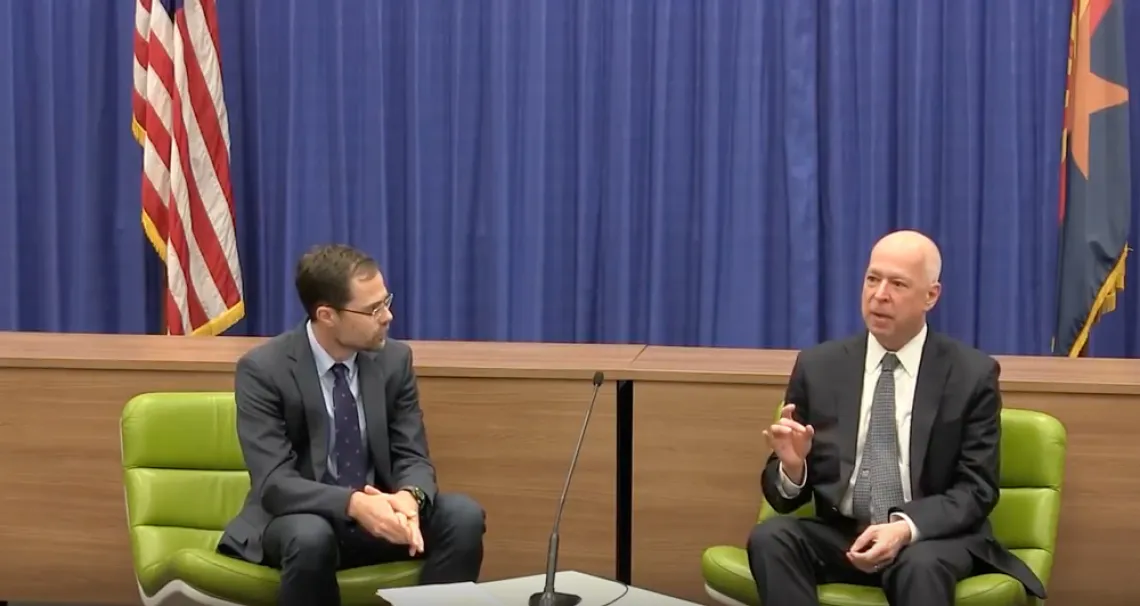New York Times Supreme Court Correspondent Talks Upcoming Cases, Mechanics of Writing for the Court During 2018 McCormick Lecture

University of Arizona Law welcomed New York Times Supreme Court correspondent Adam Liptak for the 38th annual McCormick Lecture on Feb. 12, 2018, sponsored by the college and the J. Byron McCormick Society for Law and Public Affairs. Liptak, who is also a lawyer, spoke on a number of subjects, including his thoughts on upcoming Supreme Court cases, Justice Ruth Bader Ginsburg’s speaking tour and his transition from reporter to Supreme Court correspondent.
The conversation was led by Arizona Law professor Jason Kreag, who began by asking Liptak about his thoughts on an upcoming case regarding partisan gerrymandering.
“It’s time to say the constitution forbids warping our politics in this way and if that were to happen, and it may happen in June, that would be a huge step,” Liptak said. “If we were to hear partisan gerrymandering is subject to constitutional challenge, it would re-shape American politics and would be one of the more consequential decisions we have had in many years.”
Liptak also spoke about the difference in covering the Supreme Court compared to other parts of government.
“Covering the court is not like covering the Pentagon, the Justice Department or the White House,” he said. “You are basically explaining the public acts of the court on deadline, trying to explain complicated legal materials into English. It’s not like what many of my colleagues do, which is find out secret stuff.”
When asked about Justice Ruth Bader Ginsburg’s public speaking tour and whether he thought she was trying to use her appearances to share specific messages about upcoming cases, Liptak shared that he thinks Ginsburg, along with the other justices, have the tours to talk about their journeys to the bench and provide advice to law students.
“Listen, when they want to talk to each other, they write draft opinions and circulate them,” he said. “They communicate in writing and try to persuade each other by reason and not by sending messages to the press.”
When asked about the privacy rights case Carpenter v. United States, Liptak voiced the importance of the decision. The case is about a man who was arrested for robbing electronic stores after his cell phone location data was provided to police by his cell phone company, and the data placed him near the scenes of the crimes.
“These cell phone tower records are important, they track you everywhere you go in town, and if the government doesn’t need a warrant to get that information, it’s an invasion on your privacy rights,” Liptak said. “I think it is quite possible that Mr. Carpenter wins and moreover that the court revises this quite established doctrine, in a way that will give us more rights, in an era when so much is known about us. If the court goes another way, you want to be a little nervous about your privacy rights.”
Kreag asked him if the justices are aware of President Donald Trump’s criticism of the court and what he thought the court’s role was in responding to the president’s remarks.
“The court is well aware of the attacks,” said Liptak “They are deeply problematic. They, in recent memory, are unprecedented. They do damage to the rule of law.”
Liptak said he thinks the justices would prefer to focus on their jobs rather than the president, particularly when considering the possibility of hearing cases directly related to the Trump administration, such as the travel ban or the special counsel investigation being led by Robert Mueller.
“The court needs to preserve its institutional authority because it may be heading towards a real showdown,” Liptak said.
He closed by discussing the mechanics of covering the Supreme Court and working as a columnist. His current role requires him to turn stories around as soon as the court issues a decision. He said he usually accomplishes this by pre-drafting versions of the possible outcomes so that he can complete an article once the decision is made.
“That [first draft] will get an enormous readership, and in the course of the day I will write a pretty good story for the next day’s paper, delivered to our four remaining subscribers in the Upper West Side,” he joked. “The first story will be read by millions, while the final story will be read by those four remaining people.”
